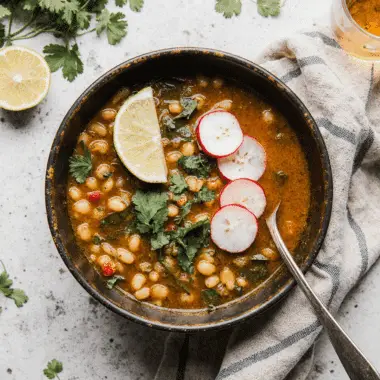Rajas con Crema is a beloved Mexican dish that celebrates the smoky richness of roasted poblano peppers paired with sweet onions and luscious Mexican crema. Traditionally served during Mexican Independence Day celebrations, this dish is not only comforting but also quick to prepare.
FULL RECIPE
Ingredients
- 5 large poblano peppers
- 1 tablespoon vegetable oil or butter
- 1 medium white onion, thinly sliced
- 2 cloves garlic, minced
- 1 cup Mexican crema (or substitute with sour cream mixed with a splash of lime juice)
- 1/2 cup whole milk (optional for thinning the sauce)
- 1/2 teaspoon salt (adjust to taste)
- 1/4 teaspoon ground black pepper
- 1/2 teaspoon chicken bouillon powder (optional, for added flavor)
- 1/2 cup shredded Oaxaca or Monterey Jack cheese (optional, for a richer dish)
- Warm corn tortillas or rice, for serving
Directions
- Roast the poblanos: Place poblano peppers directly over a gas flame or under the broiler, turning occasionally, until charred on all sides. Transfer to a bowl and cover with a towel or plastic wrap. Let steam for 10 minutes.
- Peel and slice peppers: Once cool, peel off the charred skins, remove the stems and seeds, and slice the peppers into thin strips (rajas).
- Sauté onions: In a large skillet, heat the oil or butter over medium heat. Add the sliced onions and cook for 5–7 minutes until soft and translucent.
- Add garlic and poblanos: Stir in the minced garlic and cook for 1 minute. Then add the poblano strips and sauté for another 2–3 minutes.
- Stir in crema and milk: Reduce heat to low and pour in the Mexican crema. Add milk if you prefer a looser sauce. Stir gently until well combined.
- Season and simmer: Add salt, pepper, and bouillon powder (if using). Let the mixture simmer on low heat for 5–7 minutes until heated through and slightly thickened.
- Add cheese (optional): If using cheese, sprinkle it in and stir until melted and creamy.
- Serve hot: Serve warm with corn tortillas, over rice, or as a topping for grilled meats or tacos.
Nutrition Facts
- Calories: 210
- Total Fat: 15g
- Saturated Fat: 8g
- Cholesterol: 40mg
- Sodium: 420mg
- Total Carbohydrates: 11g
- Dietary Fiber: 2g
- Sugars: 4g
- Protein: 6g
- Vitamin A: 15% DV
- Vitamin C: 80% DV
- Calcium: 15% DV
- Iron: 6% DV
Cultural Significance of Rajas con Crema
Rajas con Crema holds a cherished place in Mexican cuisine, particularly during national celebrations like Mexican Independence Day. This dish exemplifies the use of simple, regional ingredients to create bold and comforting flavors. Poblanos, indigenous to Mexico, lend their distinctive smoky heat, while crema represents the rich dairy traditions of the country. Rajas con Crema is often served alongside tamales, tacos, or rice during festive gatherings, reinforcing its role not just as a meal but as a symbol of culinary identity and pride.
Nutritional Profile and Health Benefits
While Rajas con Crema is known for its creamy decadence, it also offers several nutritional benefits. Poblano peppers are high in vitamin C, aiding immunity, and rich in antioxidants that combat inflammation. The onions provide fiber and prebiotics for gut health, while garlic offers cardiovascular benefits. Choosing light crema or Greek yogurt instead of full-fat crema can reduce calories and saturated fat, making the dish more heart-healthy. Including this meal as part of a balanced diet adds beneficial vegetables and flavor without relying on excessive processed ingredients.
Tips for Roasting Poblanos Perfectly
Achieving the signature smoky depth of Rajas con Crema depends largely on properly roasting the poblano peppers. Using an open flame on a gas burner gives the most authentic char, but a broiler or hot cast iron skillet works well too. The key is blistering the skin evenly until blackened. After roasting, placing the peppers in a covered bowl or sealed bag helps loosen the skin by steaming, making peeling effortless. Removing most of the seeds and membranes helps balance the heat and texture in the final dish.
Common Recipe Variations
There are several regional and personal variations of Rajas con Crema that add unique twists. Some cooks include kernels of sweet corn for a pop of color and natural sweetness, while others add strips of ham or bacon for a savory boost. In Oaxaca, it’s common to melt local cheeses like quesillo into the mixture for added richness. A vegan version might substitute plant-based crema and cheese while retaining the traditional flavor profile through roasted poblanos and onions. These adaptations make the dish versatile and customizable for diverse preferences.
Ideal Pairings with Rajas con Crema
Rajas con Crema pairs beautifully with a range of traditional and modern dishes. It’s a natural complement to grilled meats like carne asada or chicken fajitas, providing a creamy, smoky contrast. It also makes a satisfying vegetarian taco filling when wrapped in warm corn tortillas. Served over rice or with a side of refried beans, it becomes a comforting and hearty meal. For drinks, try pairing it with a horchata, tamarindo agua fresca, or a light Mexican lager to refresh the palate between bites.
Serving Suggestions and Presentation Tips
To elevate the presentation of Rajas con Crema, consider serving it in a rustic clay cazuela or colorful ceramic dish that highlights its heritage. Garnish with a sprinkle of fresh cilantro or crumbled queso fresco for visual contrast and added flavor. If serving as part of a taco bar, offer warm tortillas wrapped in cloth to keep them soft, and place toppings like avocado slices, lime wedges, or pickled onions nearby. Whether served at a festive gathering or a casual dinner, thoughtful plating enhances both appeal and authenticity.
Storage and Reheating Advice
Rajas con Crema stores well and often tastes even better the next day as flavors meld. Store leftovers in an airtight container in the refrigerator for up to 4 days. When reheating, use a skillet over low heat, stirring frequently to prevent scorching the crema. If the mixture thickens too much, add a splash of milk to restore its original creamy texture. While freezing is possible, the texture of the cream may change, so refrigeration is generally recommended for best results.
Gluten-Free and Dietary Adaptations
This dish is naturally gluten-free, making it suitable for people with celiac disease or gluten sensitivity when served with gluten-free sides. For those seeking a lighter version, low-fat crema or plain Greek yogurt can substitute the traditional cream. Vegan alternatives include cashew cream or coconut milk-based options paired with plant-based cheeses. The high adaptability of the recipe means that dietary needs and preferences can be easily accommodated without sacrificing the iconic flavor of the original dish.
Why Rajas con Crema is a Comfort Food Staple
Beyond its flavor and cultural importance, Rajas con Crema qualifies as a comfort food due to its warm, creamy texture and soul-satisfying qualities. The caramelized onions, smoky peppers, and rich crema evoke the essence of home-cooked meals passed down through generations. It brings a sense of nostalgia and emotional warmth, especially during family dinners or holidays. Its simplicity also makes it a go-to for quick, hearty meals after a long day, offering both nutrition and comfort in one dish.
Incorporating Rajas con Crema into Weekly Meal Planning
Rajas con Crema can be a smart addition to your weekly meal rotation due to its versatility and ease of preparation. Make a batch early in the week and use it in different ways: as a main with rice, stuffed into burritos or quesadillas, or layered on nachos for a twist. It’s an excellent vegetarian option that doesn’t skimp on flavor, making it appealing for Meatless Mondays or as a break from heavier meat-based meals. By prepping ingredients in advance, you can whip up a fresh, satisfying dish in under 30 minutes.
Conclusion
Rajas con Crema is more than just a recipe it’s a celebration of Mexican flavors, history, and culinary ingenuity. From its smoky roasted peppers to the luxurious cream sauce, every bite tells a story of heritage and home-cooked tradition. Its ability to adapt to modern dietary needs and its seamless integration into various meal settings make it a standout dish for any occasion.







